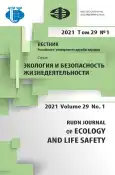Methodology for the economic estimation of the environmental damages caused by land, soil and air pollution in Kenya: a review of previously used methods
- Authors: Mamboleo M.1
-
Affiliations:
- Peoples’ Friendship University of Russia (RUDN University)
- Issue: Vol 29, No 1 (2021)
- Pages: 112-120
- Section: Environmental Economics
- URL: https://journal-vniispk.ru/2313-2310/article/view/323872
- DOI: https://doi.org/10.22363/2313-2310-2021-29-1-112-120
- ID: 323872
Cite item
Full Text
Abstract
Environmental compensation is a form of payment for pollution of nature and the environment and the destruction of land, plants or animals. One of the challenges in ensuring waste management in Kenya is how to measure the negative effect of industrial activities and waste on the environment, economy, and human health. Although the amount of compensation should be established on the basis of the environmental-economic assessment of the appropriate environment, it should also be sufficient to implement measures aimed at restoring, reproducing and improving this environment. Kenya has not yet developed a clear legal framework for compensation for environmental damage even through it has a clear and elaborate Environmental Management and Coordination Act for the protection of the environment. Previous studies on the cost of environmental damage in Kenya have successfully used two methodologies: emergency costs and soil, air, and water pollution. This works examines the essence of these methods, as well as the possibility of their application in assessing the cost of damage to the environment as a result of human economic activity.
About the authors
Martin Mamboleo
Peoples’ Friendship University of Russia (RUDN University)
Author for correspondence.
Email: mamboleomartin@gmail.com
PhD student, Department of Applied Ecology, Institute of Environmental Engineering
6 Miklukho-Maklaya St, Moscow, 117198, Russian FederationReferences
- Starett D. Shadow pricing in economics. Ecosystems. 2000;3:16-20.
- Alfsen KH, De Franco MA, Glomsrød S, Johnsen T. The cost of soil erosion in Nicaragua. Ecological Economics. 1996;16(2):129-145.
- Cohen MJ, Brown MT, Shepherd KD. Estimating the environmental costs of soil erosion at multiple scales in Kenya using emergy synthesis. Agriculture, Ecosystems & Environment. 2006;114(2-4):249-269.
- Odum HT, Brandt-Williams SL, Nilsson PO. Folio 1. Introduction and global budget. Handbook of Emergy Evaluation: A Compendium of Data for Emergy Computation Issued in a Series of Folios. Gainesville: Center for Environmental Policy, University of Florida; 2000.
- Barber RG. The magnitude and sources of soil erosion in some humid and semi-arid parts of Kenya and the significance of soil loss tolerance values in soil conservation in Kenya. Soil and Water Conservation in Kenya: Proceedings of the Second National Workshop. Nairobi: Institute for Development Studies; 1983.
- Doherty SJ, Odum HT, Nilsson PO. Emergy evaluation of forest production and industries in Sweden. Uppsala: Institutionen for Bioenergi; 2002.
- Ulgiati S, Bastianoni S, Odum HT. Emergy use, environmental loading and sustainability an emergy analysis of Italy. Ecological Modelling. 1994;73(3-4):215-268.
- Lanoie P, Tavenas S. Costs and benefits of preventing workplace accidents: the case of participatory ergonomics. Safety Science. 1996;24(3):181-196.
Supplementary files









